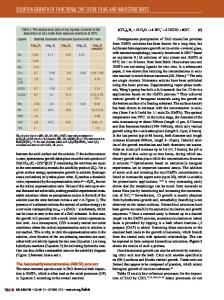Low Temperature Growth and Application of Zinc Oxide Nanowires using Zinc Oxide Seeds
- PDF / 899,543 Bytes
- 5 Pages / 612 x 792 pts (letter) Page_size
- 35 Downloads / 365 Views
1018-EE05-19
Low Temperature Growth and Application of Zinc Oxide Nanowires using Zinc Oxide Seeds Lee Sunyoung, Myoung Hey Jin, Maeng Sunglyul, and Kim Sang-Hyeob Cambridge-ETRI Joint R&D Centre, Electronics and Telecommunications Research Institute, 161 Gajeong-Dong, Yuseong-gu, Daejon, 305-700 KOREA, Daejon, Korea, Republic of ABSTRACT The growth of ZnO nanowire arrays on a variety of substrates using a chemical wet process is presented. ZnO seeds can act as a nucleation layer for wire growth and ZnO nanowire arrays can have direct contact with a variety of substrates. The structural and optical properties of ZnO nanowire arrays grown at 90 oC are investigated. FESEM and X-ray diffraction observations reveal that the crystalline ZnO nanowire arrays are preferentially oriented along the c axis. The room temperature photoluminescence (PL) measurements had shown ultraviolet peaks and a deep level peak. After annealing at 900oC for 1 min. by RTA, the deep level peak became much weaker and the band-edge emission PL was much stronger. INTRODUCTIONS ZnO nanowires with a band gap of 3.37 eV are semiconducting materials. Many deposition methods have been used to fabricate the ZnO such as chemical vapor deposition (CVD)[1], metal organic chemical vapor deposition(MOCVD)[1], pulse laser deposition[2], and anodized aluminum oxide membrane[3]. The chemical wet process showed some advantages compared with others, such as the use of simple equipment, low temperature deposition (100oC), lower cost, less hazardous, and elimination of the need for metal catalysts. In our work, the chemical wet process was used because of these advantages. We show that by using the chemical wet process ZnO nanowire arrays can be grown on a variety of substrates. The structural and optical properties of ZnO nanowire arrays are analyzed by FESEM, XRD, TEM, and PL, which show that single-crystal ZnO nanowire arrays are obtained at temperatures below 100∞C when ZnO seeds are used. EXPERIMENTAL DETAILS The substrates used in this study include Si wafers, glass, and ITO. ZnO seeds were synthesized from a zinc acetate dehydrate solution in methanol[4] and spin coated onto the substrate surface. The ZnO coated substrates were also subjected to an annealing process at 400oC for 5-10 min. to decompose zinc acetate. The decomposition of zinc acetate is an established route to the formation of ZnO colloids and nanocrystals in aqueous solution[5]. We used this approach to form ZnO seeds on substrate by thermally decomposing the zinc acetate. Vertically aligned ZnO nanowire arrays are grown by the chemical wet process. After the substrates are seeded, the nanowires are grown by placing the substrates in an aqueous solution of zinc nitrate hexahydrate and hexamethylenetetramine. The aqueous solution is kept at 90oC throughout the growing process[6]. The sample is rinsed in flowing de-ionized water immediately after removal from the growth solution to remove any residual material on the
surface. An FESEM (field-emission scanning electron microscope) was used to
Data Loading...










